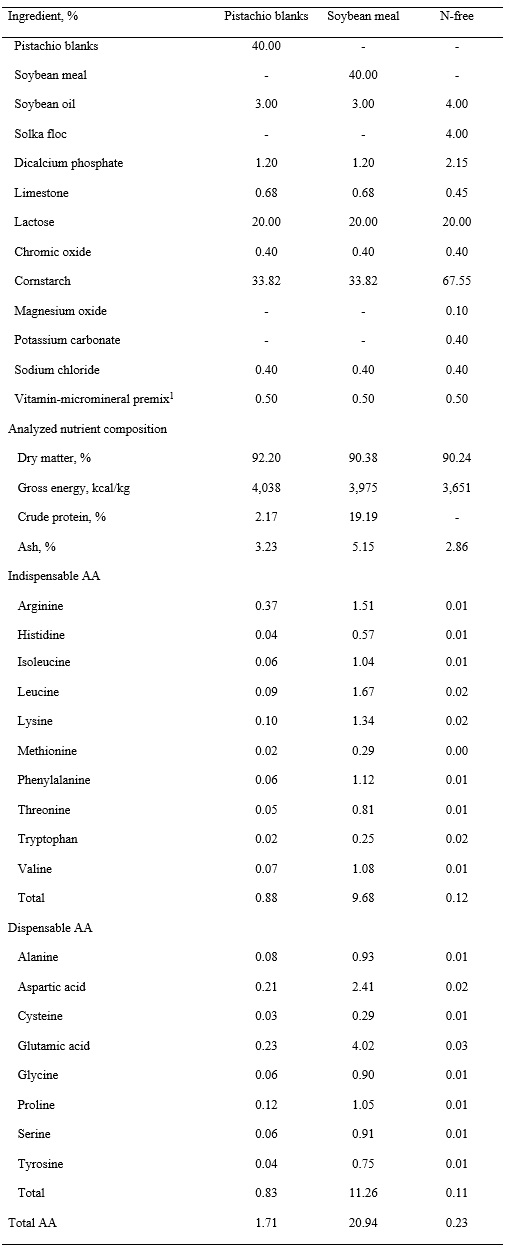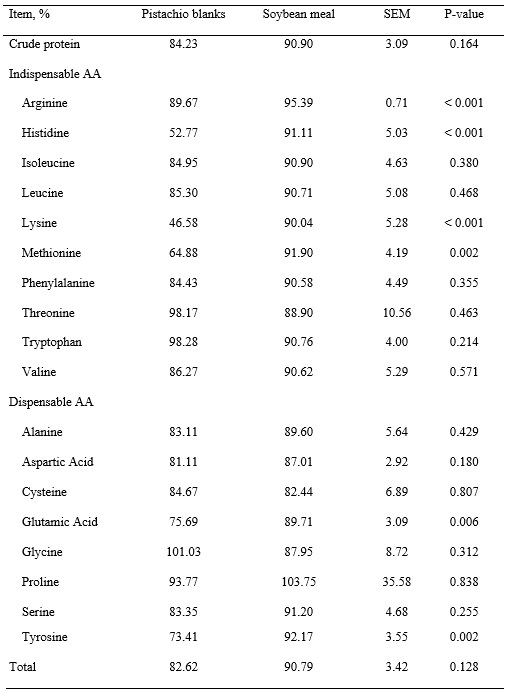Pistachio blanks are coproducts of pistachio processing and are discarded due to their hollow shells or immature nuts, which make them unusable as human food. Pistachio blanks float in water and the annual production is estimated to be between 50,000 and 70,000 metric tons. A similar coproduct, pistachio shell powder, was recently demonstrated to provide significant amounts of energy in diets for sows. However, there is no information about the digestibility of amino acids (AA) in pistachio blanks when fed to pigs. Although AA concentration in pistachio blanks is low, there is a need for determining standardized ileal digestibility (SID) of AA in pistachio blanks. Therefore, an experiment was conducted to test the hypothesis that the SID of AA in pistachio blanks are comparable to those in soybean meal (SBM) when fed to growing pigs.
Experimental Design
Pistachio blanks were procured from Wonderful LLC (Los Angeles, CA, USA), and conventional dehulled SBM was procured from Solae LLC (Gibson City, IL, USA; Table 1). Two diets that contained pistachio blanks or SBM as the sole source of AA were formulated. An additional N-free diet was formulated to measure basal endogenous losses of crude protein (CP) and AA (Table 2). Vitamins and minerals were included in all diets to meet or exceed current requirement estimates. All diets also contained 0.4% chromic oxide as an indigestible marker. All pigs were fed at a daily level of 3.4 times the estimated energy requirement and water was available at all times.
Animals and Housing
Nine growing barrows (initial body weight: 22.67 ± 0.93kg) were equipped with a T-cannula in the distal ileum. Pigs were the offspring of Line 800 males mated to Camborough females (Pig Improvement Company, Hendersonville, TN, USA) and were allotted to a triplicated 3 × 3 Latin square design with 3 diets and three 7-day periods, therefore, there were 9 replicate pigs per treatment. Pigs were housed in individual pens (1.2 × 1.5 m) in an environmentally controlled room with the ambient temperature maintained between 20 and 24 oC. Pens had smooth sides and fully slatted tribar floors. A feeder and a nipple drinker were installed in each pen.
Sample Collection
Each period of the Latin square lasted 7 days, and the initial 5 days of each period were considered the adaptation period to the diet, whereas ileal digesta were collected on days 6 and 7 for 9 hours each day. By attaching a plastic bag to the opened cannula barrel using a cable tire, digesta that flowed into the bag were collected. Bags were replaced every time they were filled with digesta or at least once every 30 minutes. Digesta samples were immediately frozen at – 20oC to prevent bacterial degradation of the AA in the digesta. Pig weights were recorded at the beginning of each period and at the conclusion of the experiment. The amount of feed supplied each day was recorded. On the completion of one experimental period, animals were deprived of feed overnight and the following morning, a new experimental diet was offered.
Results
The SID of CP was not different between pistachio blanks and SBM (Table 3). The SID of Ile, Leu, Phe, Thr, Trp, Val, Ala, Asp, Cys, Gly, Pro, and Ser were also not different between pistachio blanks and SBM, but the SID of Arg, His, Lys, Met, Glu, and Tyr was greater (P < 0.05) in SBM than in the pistachio blanks.
Conclusion
The SID of some, but not all, AA in pistachio blanks are less than in soybean meal (SBM) when fed to growing pigs
Appreciation
Funding for this research form the Wonderful company (Los Angeles, CA) is greatly appreciated.
Table 1. Analyzed nutrient composition of feed ingredients, as-is basis

Table 2. Composition (as-is basis) of experimental diets

1The vitamin-micromineral premix provided the following quantities of vitamins and micro minerals per kg of complete diet: vitamin A as retinyl acetate, 10,622 IU; vitamin D3 as cholecalciferol, 1,660 IU; vitamin E as selenium yeast, 66 IU; vitamin K as menadione nicotinamide bisulfate, 1.40 mg; thiamin as thiamine mononitrate, 1.08 mg; riboflavin, 6.49 mg; pyridoxine as pyridoxine hydrochloride, 0.98 mg; vitamin B12, 0.03 mg; D-pantothenic acid as D-calcium pantothenate, 23.2 mg; niacin, 43.4 mg; folic acid, 1.56 mg; biotin, 0.44 mg; Cu, 20 mg as copper chloride; Fe, 123 mg as iron sulfate; I, 1.24 mg as ethylenediamine dihydriodide; Mn, 59.4 mg as manganese hydroxychloride; Se, 0.27 mg as sodium selenite and selenium yeast; and Zn, 124.7 mg as zinc hydroxychloride.
Table 3. Standard ileal digestibility of crude protein and amino acids (AA) in pistachio blanks and soybean meal
